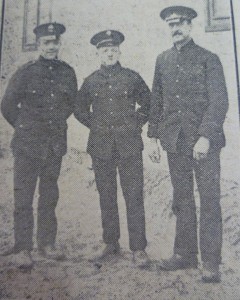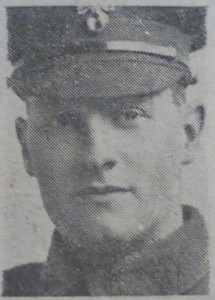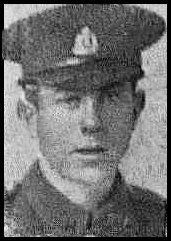In September 1914, 125,000 French and 94,000 Russian prisoners of war were imprisoned. By the end of the First World War nearly 200,000 British soldiers had also been captured. The majority were taken from the Western Front, particularly in March, April and May 1918 following German attacks on the Somme and the Chemin des Dames near Reims. At first the prisoners would be taken to a camp near to the battlefields, before then being taken back to Germany. In many cases whole battalions were captured, killed or wounded in one assault.
At first prisoners lived in temporary accommodation which was improvised and in a very bad condition, with fears that such conditions would attract diseases such as, cholera and typhoid, which could spread to the civilian population. From 1915 wooden barrack camps were constructed with straw or sawdust beds in two layers on each side of a corridor. There were also chairs, a table and a stove. Each barrack was over 15 meters long and housed 250 men per wooden barrack. Each camp also had facilities for washing and toilets, as well as religious and cultural activities such as sports, entertainments and libraries. Each camp was surrounded by barbed wire and armed guards. Eventually there were prisoner of war camps all over Germany and in North and North East France. There were also special camps for those who were in ill health or injured situated in Switzerland and the Netherlands. Officers were usually imprisoned separately to their men, and in some camps British prisoners of war would mix with those from France, Belgium and Russia. By October 1918 over two million Allied prisoners of war were held in these camps.
At the start of the War new prisoners were paraded around the towns and were mocked by spectators. Sightseeing visitors were also invited into the camps including children. However, as the Allies began to take German prisoners of war as well, the mood changed. The treatment of prisoners varied greatly. Some were treated very well, while others were forced to work in factories, mines, building railways and roads and working as stretcher bearers behind enemy lines, often for 10 hours a day. Food was often scarce and usually consisted of soup with bread made from bran and potato. Many British and French prisoners received food parcels from home, which helped to supplement their diet and were envied by the starving German personnel! In 1918 as Germany began to starve due to the success of the Allied submarine blockades, the prisoners found themselves with extremely little food. In the last year of the war many prisoners died of sickness and malnutrition. Nearly 20,000 British Prisoners of War died in the camps in Germany.
Discipline was also very strict. Failing to salute an officer, refusing to answer at role call and insubordination earned successive degrees of punishments for each offence. Crimes such as sabotage and spying were judged at tribunals. There were also certain camps which were “punishment” camps. Treatment in these camps was extremely harsh. Prisoners could be used for rebuilding trenches or collecting the dead from the Front. Many prisoners died in these punishment camps and in Sedan some were executed.
Prisoners of War were not only taken from the Western Front. In Gallipoli at Suvla Bay in 1915 prisoners were captured by Turkish troops, British prisoners were also taken in Palestine and Salonika, the Bolsheviks captured some in Russia between 1918-1919 and in Mesopotamia (Iraq) in April 1916, Turkish troops forced a surrender which resulted in over 13,000 British and Commonwealth troops being taken prisoner. Many more prisoners were taken by the Turkish troops although accurate records have not survived. By the end of the War 70% of these prisoners of war had died. They were forced to endure hard labour, building railways and roads and there was no separation of offices and men. Merchant Navy Sailors were also captured at sea and imprisoned in Germany as prisoners of war.
During the War, the War Office published lists which contained details of the fallen, wounded and missing soldiers as well as prisoners of war. At first these included detailed information but as the war raged on the details become less and less. The Bexhill Observer published similar details within its regular Roll of Honour for local men; however the Roll of Honour disappeared from the newspaper in early 1916.
The Red Cross
The Red Cross played an important role in helping prisoners of war survive. They were given access to new prisoners soon after they were captured and helped the soldiers to write a postcard to send home to their families, stating they were alive but had been captured and were now prisoners of war. The Red Cross kept records about each prisoner including their health and transfers to other camps. If a prisoner died they would also hold an enquiry to discover how and why it had happened. Another role was liaising with families back home in Britain and representatives from the Red Cross would often form part of the inspection teams for the prisoner of war camps.
Bexhill’s Prisoners of War
In January 1919 Mrs Kate Rawlins of Rotherfield Avenue, who had spent the war sending parcels to British prisoners of war in Germany, organised a welcome home dinner for Bexhill’s Prisoners of War. So determined was she to bring as many together as possible, the Bexhill Observer reported “taxis were even sent for four men from Catsfield and four from Ninfield and Hooe”. The report also listed the names of the 34 POWs who attended. These were their names:
- Corporal J Dadswell – Royal Sussex Regiment
- Lance Corporal A. B Elgar – Royal Sussex Regiment
- Lance Corporal W. Ford – Royal Sussex Regiment
- Lance Corporal Burchett – Royal Sussex Regiment
- Signaller W.J Close – Royal Sussex Regiment
- Private W.I Gaston – Royal Sussex Regiment
- Private H. Makin – Royal Sussex Regiment
- Private H Waters – Royal Sussex Regiment
- Private P.H Preston – Royal Sussex Regiment
- Private G. Benge – Royal Sussex Regiment
- Private A. Bishop – Royal Sussex Regiment
- Private J Darby – Royal Sussex Regiment
- Private J Stubberfield – Royal Sussex Regiment
- Sergeant W.B Goodwin – Kings Own Yorkshire Light Infantry
- Private W.D Mantle Kings Own Yorkshire Light Infantry
- Lance Corporal J Steabben – Rifle Brigade
- Bombardier E Deeprose – Royal Garrison Artillery
- Private J.B Hopper – Buffs/Kents
- Private H.W Terry – Cameron Highlanders
- Private A.F Tibbler – Lincolns
- Private H.L Fry – Coldstream Guards
- Private T Morgan – Kings Own Royal Lancasters
- Private A Akehurst – Royal West Kent
- Private W.C.S Morley – Queens Own Royal West Surrey
- Private A Smith – Royal Warwickshire
- Private L Benge – 4th Battalion Tank Corps
- Private W.H Warburton – Grenadier Guards
- Private S Harmer – East Surrey
- Private J Ashton – Royal West Kent
- Private J.T Harmer – Manchester Regiment
- Private J.G Honeysett – Lancashire Fusiliers
- Private H.W Kent – London Royal Fusiliers
- Private Arthur Lay – Royal Berks
- Chief Stoker Porter – HMS Maori
Two other POWs, Corporal Paxton of the Norfolks, and Private G.R.H Jones of the Royal West Kents were in hospital so were unable to attend. Photographs were also circulated of two missing Bexhill soldiers Private F.W Cannon of the Royal Sussex Regiment and Private F.H Rice of the Grenadier Guards who were presumed to be prisoners of war.
Throughout the War and the in the immediate aftermath in 1919, the local newspapers also began to publish some of the prisoners of war’s stories. The full articles have been transcribed and are available under Prisoners of War in the menu on the left.
Private George Eden Royal Army Medical Corps (R.A.M.C) (his sister Mrs George Abbott lived at Holly Cottage Belle Hill) was captured in August 1914 at the start of the war following the Battle of Mons. He was released in July 1915. He was one of 250 R.A.M.C taken prisoner and was sent to Paderborn Camp in Westphalia.
 Corporal J Dadswell of the Royal Sussex Regiment lived at 21 North Street, Sidley and had trained at Cooden Camp. He was taken prisoner in 1916 and was wounded in the shoulder, the muscle of his arm and had been shot through the knee. He was imprisoned until 1918. On arrival in Germany he – and many other POWs- were paraded through the town in buses and carts to be shown off to the Germans back at home. He was first sent to Standel camp, but later he was sent to Wittonberg-on-Elbe which was a punishment camp, intended to be a reprisal for German POWs who were working hard back in England. The camp was also known as the “Hell of Germany”.
Corporal J Dadswell of the Royal Sussex Regiment lived at 21 North Street, Sidley and had trained at Cooden Camp. He was taken prisoner in 1916 and was wounded in the shoulder, the muscle of his arm and had been shot through the knee. He was imprisoned until 1918. On arrival in Germany he – and many other POWs- were paraded through the town in buses and carts to be shown off to the Germans back at home. He was first sent to Standel camp, but later he was sent to Wittonberg-on-Elbe which was a punishment camp, intended to be a reprisal for German POWs who were working hard back in England. The camp was also known as the “Hell of Germany”.
Private J T Harmer of the 2/5th Manchester Regiment lived at 18 Camperdown Street, Sidley. He was captured on the 21st March 1918 and spent the majority of his captivity working in the salt mines.
 Private W. H Warburton of the Grenadier Guards lived at Greenhyrst, Station Road, Bexhill. He was captured in April 1918. At first he had a very rough time in the camps as he was forced to work building railways and roads, carrying bricks up ladders and working as a stretcher bearer behind the German lines for both German and British troops. He then became ill after developing influenza. After three weeks in hospital he was sent to a convalescent camp in Germany and his treatment greatly improved. Like many others he was very grateful for the packages of food he received from home.
Private W. H Warburton of the Grenadier Guards lived at Greenhyrst, Station Road, Bexhill. He was captured in April 1918. At first he had a very rough time in the camps as he was forced to work building railways and roads, carrying bricks up ladders and working as a stretcher bearer behind the German lines for both German and British troops. He then became ill after developing influenza. After three weeks in hospital he was sent to a convalescent camp in Germany and his treatment greatly improved. Like many others he was very grateful for the packages of food he received from home.
Lance Corporal A. B Elgar of the 9th Battalion Royal Sussex Regiment lived at 24 Windsor Road. He was captured in March 1918 and was sent to Lagensalza camp. He was not badly treated and spent his time working as a plate layer on the railway.
Private H Makin of the Royal Sussex Regiment lived at 14 Salisbury Road, Bexhill. He was captured in April 1918. He was already well known in Bexhill as it had been reported in the Bexhill Observer that when he was in France he had undergone a transfusion of blood to a fellow soldier. While he was imprisoned he had a very hard time behind the German lines, including an incident where a German soldier struck him on the ankle causing an injury serious enough to require hospitalisation.
 Private H. E Prosser of the Hampshire Regiment spent nearly the entire War as a prisoner of war as he was imprisoned for 4 years in Germany, with some time spent in the Sennelager camp.
Private H. E Prosser of the Hampshire Regiment spent nearly the entire War as a prisoner of war as he was imprisoned for 4 years in Germany, with some time spent in the Sennelager camp.


